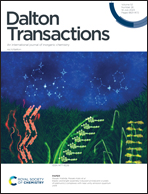Syntheses and magnetic properties of a bis-bidentate nitronyl nitroxide radical based on triazolopyrimidine and its metal complexes†
Abstract
A novel bis-bidentate nitronyl nitroxide radical based on triazolopyrimidine, NIT-2-TrzPm (NIT-2-TrzPm = (2-(2′-triazolopyrimidine)-4,4,5,5-tetramethyl-4,5-dihydro-1H-imidazol-1-oxy-3-oxide)) and six new transition metal complexes of this ligand, namely [M(hfac)2(NIT-2-TrzPm)]·CH2Cl2 (M = Mn (1Mn) and Co (2Co)), [M(hfac)2]2(NIT-2-TrzPm) (M = Mn (3Mn) and Co (4Co)), [Mn(NIT-2-TrzPm)2(MeOH)2](ClO4)2·MeOH (5Mn), and [Co(NIT-2-TrzPm)2(MeOH)2]2(ClO4)4·4MeOH (6Co) were prepared and characterized structurally and magnetically. These complexes can be selectively synthesized by controlling the reaction ratio of M(hfac)2·2H2O to the radical ligand (for 1Mn to 4Co) or using metal perchlorates as the starting materials (for 5Mn and 6Co). Single crystal X-ray crystallographic analyses confirmed that 1Mn and 2Co are isostructural 3d–2p MII–radical complexes, in which the NIT-2-TrzPm radical acts as a terminal bidentate ligand chelating to one 3d ion, while 3Mn and 4Co are isostructural 3d–2p–3d MII–radical–MII complexes with the NIT-2-TrzPm radical acting as a bridging ligand between two 3d ions. For complexes 5Mn and 6Co, two NIT-2-TrzPm ligands from the equatorial positions coordinate with the metal center to form the 2p–3d–2p structures with the axial positions occupied by two methanol molecules. Magnetic analysis on the MnII complexes revealed the existence of a strong antiferromagnetic interaction between the MnII and the NIT radical spin, while weak ferromagnetic coupling for Mn⋯Mn and Rad⋯Rad in the Mn–NIT–Mn and Rad–Mn–Rad spins was confirmed. Interestingly, although the NIT-bridged complexes 3Mn and 4Co possess significantly different magnetic anisotropy, field-induced slow magnetic relaxation can be observed in both complexes, which was assigned to the phonon bottleneck effect for 3Mn and field-induced SMM behavior for 4Co. To the best of our knowledge, 3Mn is the first example of the NIT-bridged binuclear MnII complex undergoing slow magnetic relaxation.



 Please wait while we load your content...
Please wait while we load your content...